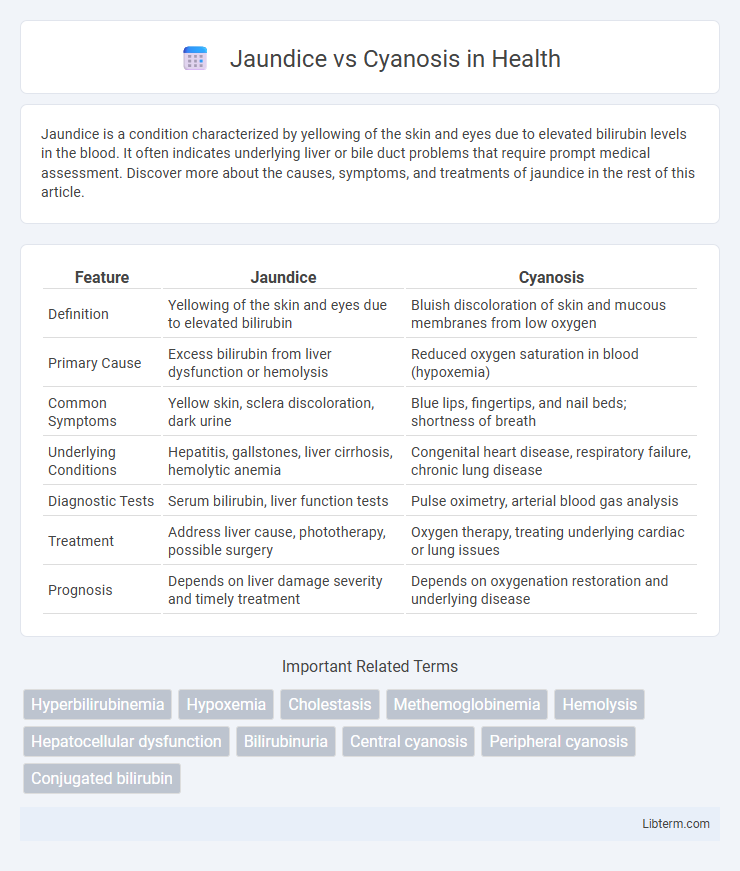Jaundice is a condition characterized by yellowing of the skin and eyes due to elevated bilirubin levels in the blood. It often indicates underlying liver or bile duct problems that require prompt medical assessment. Discover more about the causes, symptoms, and treatments of jaundice in the rest of this article.
Table of Comparison
| Feature | Jaundice | Cyanosis |
|---|---|---|
| Definition | Yellowing of the skin and eyes due to elevated bilirubin | Bluish discoloration of skin and mucous membranes from low oxygen |
| Primary Cause | Excess bilirubin from liver dysfunction or hemolysis | Reduced oxygen saturation in blood (hypoxemia) |
| Common Symptoms | Yellow skin, sclera discoloration, dark urine | Blue lips, fingertips, and nail beds; shortness of breath |
| Underlying Conditions | Hepatitis, gallstones, liver cirrhosis, hemolytic anemia | Congenital heart disease, respiratory failure, chronic lung disease |
| Diagnostic Tests | Serum bilirubin, liver function tests | Pulse oximetry, arterial blood gas analysis |
| Treatment | Address liver cause, phototherapy, possible surgery | Oxygen therapy, treating underlying cardiac or lung issues |
| Prognosis | Depends on liver damage severity and timely treatment | Depends on oxygenation restoration and underlying disease |
Introduction to Jaundice and Cyanosis
Jaundice is a medical condition characterized by a yellow discoloration of the skin, mucous membranes, and eyes due to elevated bilirubin levels in the blood. Cyanosis presents as a bluish tint in the skin and mucous membranes caused by insufficient oxygen in the blood or poor circulation. Both conditions indicate underlying health issues related to blood constituents but differ in their causes and visual manifestations.
Definition of Jaundice
Jaundice is a medical condition characterized by yellowing of the skin, mucous membranes, and eyes due to elevated levels of bilirubin in the blood. Bilirubin is a yellow pigment produced during the breakdown of red blood cells, and its accumulation indicates liver dysfunction or bile duct obstruction. Unlike cyanosis, which manifests as a bluish discoloration caused by insufficient oxygenation, jaundice specifically reflects abnormalities in bilirubin metabolism and liver health.
Definition of Cyanosis
Cyanosis is a medical condition characterized by a bluish discoloration of the skin and mucous membranes due to insufficient oxygen in the blood. Unlike jaundice, which results from elevated bilirubin levels causing yellowing of the skin, cyanosis indicates underlying respiratory or cardiovascular issues. Detecting cyanosis is crucial for diagnosing hypoxemia and initiating appropriate treatment for oxygen deficiency.
Causes of Jaundice
Jaundice occurs due to the accumulation of bilirubin in the blood, primarily caused by liver diseases such as hepatitis, cirrhosis, or bile duct obstruction. Hemolytic anemia and genetic disorders like Gilbert's syndrome also contribute to increased bilirubin production or impaired processing. Unlike cyanosis, which results from low oxygen levels in the blood, jaundice's hallmark is yellowing of the skin and eyes caused by hyperbilirubinemia.
Causes of Cyanosis
Cyanosis primarily results from conditions that reduce oxygen levels in the blood, such as respiratory disorders like chronic obstructive pulmonary disease (COPD), congenital heart defects including Tetralogy of Fallot, and circulatory problems like peripheral artery disease. Central cyanosis is caused by systemic arterial oxygen desaturation, often due to lung illnesses impairing gas exchange, while peripheral cyanosis stems from local blood flow reductions or increased oxygen extraction in tissues. Identifying these underlying causes is crucial for accurate diagnosis and treatment of cyanosis.
Signs and Symptoms Comparison
Jaundice is characterized by yellowing of the skin and sclera due to elevated bilirubin levels, often accompanied by dark urine and pale stools, while cyanosis presents as a bluish discoloration of the skin and mucous membranes caused by decreased oxygen saturation in the blood. Both conditions manifest visually, but jaundice primarily affects the eyes and skin's yellow pigmentation, whereas cyanosis impacts peripheral and central areas with a blue tint. Key symptoms of jaundice include itching and fatigue, whereas cyanosis may be associated with shortness of breath and cold extremities.
Diagnostic Differences
Jaundice is diagnosed primarily through elevated bilirubin levels in blood tests and yellow discoloration of the skin and sclera, indicating liver dysfunction or hemolysis. Cyanosis is identified by a bluish tint to the skin and mucous membranes due to increased levels of deoxygenated hemoglobin, often confirmed by measuring arterial oxygen saturation and blood gas analysis. Diagnostic imaging and pulse oximetry help differentiate between these conditions by assessing oxygenation status and liver function parameters.
Impact on Body Systems
Jaundice primarily affects the hepatic and hematologic systems by causing elevated bilirubin levels, leading to yellowing of the skin and eyes, and can impair liver function and bile metabolism. Cyanosis impacts the cardiovascular and respiratory systems due to insufficient oxygenation of the blood, resulting in a bluish discoloration of the skin and mucous membranes. Both conditions indicate underlying systemic dysfunctions requiring targeted diagnostic and therapeutic approaches to prevent progression and organ damage.
Treatment Approaches
Treatment approaches for jaundice primarily target underlying causes such as liver dysfunction, hemolysis, or bile duct obstruction, often involving phototherapy for neonatal jaundice or medications to support liver health. Cyanosis treatment focuses on improving oxygenation and addressing cardiopulmonary issues, including supplemental oxygen, mechanical ventilation, or surgical correction for congenital heart defects. Both conditions require precise diagnosis to guide interventions that resolve symptoms and prevent complications.
Prevention and Prognosis
Effective prevention of jaundice involves maintaining proper liver health through vaccination against hepatitis, avoiding excessive alcohol consumption, and managing underlying conditions such as gallstones or infections. Cyanosis prevention focuses on ensuring adequate oxygenation by addressing cardiovascular or respiratory disorders early, including congenital heart disease and chronic lung diseases. Prognosis for jaundice depends on the underlying cause, with neonatal jaundice often resolving with treatment, while chronic liver disease may require long-term management; cyanosis prognosis varies based on the severity of oxygen deprivation and underlying cardiopulmonary conditions.
Jaundice Infographic

 libterm.com
libterm.com